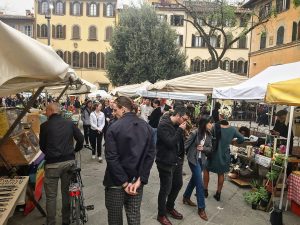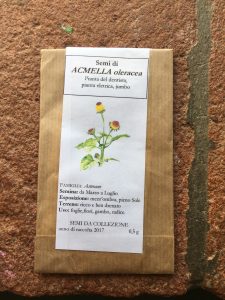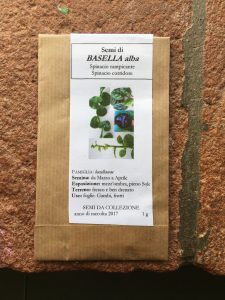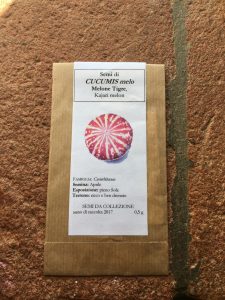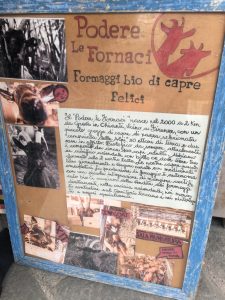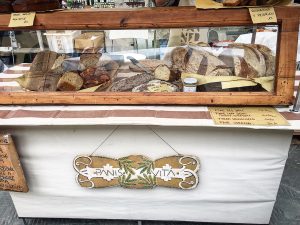FIerucola is a market that takes place at the Piazza SS Annunziata in Firenze every third Sunday of the month. It looks like most typical farmer’s markets with vegetable, mushroom, jam makers, other value-added products, and local artist vendors, but its origins are a little more anarchist than the generally regulated markets you’re used to going to on the weekend. The Fierucola del Pane Association was started in December of 1984 to push back against industrial agriculture. It was started as way for peasants to build a community to support one another and their products, inviting participants who believe in small family farms, local farms, and non-entrepreneurs to help rebuild Italian rurality.
I was shown this market by a friend of Lane Selman’s, Robin Morgan. Robin has been studying agriculture at the University of Pisa, specifically looking at breeding lines of spelt. He and his partner Irene, who is now studying herbalism, but who has worked as a pastry chef in Michelin starred restaurants, were kind enough to show me the best stops at this market.
When we first arrived we talked to Paolo, he and his father Pierluigi started the organization called Piante Innovative in 2008. Both father and son have had a deep passion for seeds and the stories behind them. They collected and cultivated uncommon plants and in 2010 Paolo set out to spread the word of these seed throughout Toscana. Paolo is incredibly passionate collecting and distributing seed as well as all of the history behind the seeds. During our discussion, I was constantly nodding my head and saying “si” (even though he was speaking English, I try to use the ten words I know in Italian any chance I get) to his philosophy on food and art that comes with seed preservation. He helped me choose a few interesting plants to bring back with me. Here’s the list, I’ve translated what is listed on their website or the seed packed into English:
Acmell oleracea
Family: Compositae
Origin: South America; spread throughout the world
Characteristics: small upright plant, of rapid growth very decorative due to the curious and numerous red-yellow inflorescences.
Cultivation: prefers drained and Humus-rich soils with widespread humidity; full sun or partial shade. It is sown in May with temperatures of at least 18 ° C; it is perennial in mild climates or if protected from the cold. The plant spreads with its characteristic inflorescence, it fears snails attacks.
Therapeutic value: L ‘ Acmella oleracea has mucolytic action, promotes digestion and has an anesthetic effect; the decoction or infusion of leaves and flowers is a traditional remedy for stuttering, toothache and stomatitis; chewing leaves and flowers strengthens the gums, soothes toothache and refreshes the throat; an extract made with this plant should visibly and quickly reduce facial wrinkles. In many countries, this plant is also used effectively in cases of bronchitis, burns, headaches, migraines and itching.
Edibility: it is a valid alternative to the most common and tasty spices; the particular fresh and “spicy” sensation for lips and palate caused by the leaves and flowers in the shape of the button just picked up gives it a unique taste; thanks to its spicy aroma, this spicy herb is suitable for soups, salads or special vegetable side dishes. If cooked, the leaves lose part of their spicy flavor and can be used as vegetables. In Brazil it is used combined with chili and garlic to enrich other dishes with flavor and vitamins. The flower alone has a grassy taste immediately followed by an almost electric tingling and excessive salivation; in India flowers are used together with chewing tobacco.
History: the vulgar name seems to derive from the Brazilian province Para, a term that is taken up in almost all the vulgar names given to this plant also abroad. It is unbelievable that the plant is completely unknown as a spice outside of Brazil and neighboring countries. For the kitchen, this innovative herb can be an interesting alternative to spicy spices that are used in western cuisine. Since 2000 this plant is subject to careful studies because of its many and particular substances used in many recipes, studies and medicinal preparations; noteworthy is the spilantolo which stimulates the receptor in the oral cavity responsible for salivation. An effective insecticide has been produced for many decades by the concentrated extracts of this plant.
Cucurbita ficifolia
“7 year old pumpkin, siamese, pumpkin, fig leaf pumpkin, chilacayote”
Family: Cucurbitacea
Origin: Mexico
Characteristics: perennial climber with rapid growth and late fructification, resistant to cold, but not to frost. Monomic flowers pollinated by insects. Self-fertile species.
Cultivation: it thrives in rich and well drained soils and in bright and sheltered warm locations, but tolerates many conditions and is well suited even in poor soils. In temperate climates it is cultivated as annual. Plant very vigorous, can reach several meters in length climbing trees and nets, sometimes exceeding 15-20 meters in a single year. The plant follows the photoperiod and flowers at the end of summer, arriving to ripen the fruit in late autumn. Does not hybridize with other members of its kind.
Therapeutic value: the seeds are vermifugos; they are used together with the shell. They are minced and reduced to powder, then emulsified with a little water and eaten. As a remedy for internal parasites, the seeds are less potent than the root of Dryopteris filixmas, but they are safer for pregnant women, debilitated patients and children. After a possible treatment, it seems necessary to take a purge to expel the parasites from the body.
Edibility: often the fruits are consumed young, still green, raw or cooked; excellent if sautéed or sautéed like zucchini to season pasta and omelets; raw are used in salads like cucumbers, but they are tastier. The ripe fruits that are not very useful in savory dishes are very suitable for making jams and candied. The sugar is added to the pulp, and during the cooking the consistency becomes stringy and fragrant. The ripe fruits can be stored for 2 years or more and become sweeter with storage. It is one of the most productive and consumed pumpkins in the hot countries of the world. In Ecuador, you make a juice called zambo. The seed is rich in oil with a nutty flavor, but difficult to extract given its fibrous layer; excellent toasted and consumed like a peanut. Also from the seeds you get an edible oil rich in oleic acid.
History: The story tells that this type of pumpkin arrived in France at the beginning of the twentieth century, precisely at the “jardin du plantes” directly from Mongolia, along with the first yaks ever seen in Europe. Given its shelf life this fruit was used as food for animals during the long journey made. The spread of this plant in Europe came as a result of this event. Rustic pumpkin, which takes its name from its leaves in the shape of fig leaves; the fruit of a color similar to watermelon is characterized by a strong rind that makes it durable (up to 7 years) and resistant to rotting. It stands out for its strength of growth with vigorous shoots, and high productivity. It is an excellent rootstock of Cucumis sativus (cucumber) giving it more vigor, productivity and resistance to disease. This species is the most robust of its kind and does not naturally hybridize with other pumpkins (although cross-breeding can be obtained under controlled conditions). In America, it takes 3 months from the seed to the first harvest and 6 months to get ripe fruit. The shell of ripe fruit is very hard and can be used as a container.
BASELLA rubra- BASELLA alba
“Spinach of Malabar, spinach runner or creep”
Family: Basellaceae
Origin: Asia, Africa
Habitat: wet places
Characteristics: perennial climbing plant, with cuneiform or heart-shaped fleshy and waxed leaves that can quickly reach 9 m in height in the country of origin (in the Mediterranean climate it reaches heights of 2-3 m); it blooms from May to September and the flowers are hermaphrodites. The alba variety has white flowers and green leaves, the rubra has purple flowers and reddish leaves. The plants are photosensitive and bloom with a duration of less than 13 hours; fear frost;
Cultivation: suitable for all types of soil as long as they are well drained, Basella is easy to grow and loves bright and fresh soil, it also tolerates acid soils and very rainy seasons. It grows well with temperatures above 15 ° C, provide the plant with a support where to climb. Due to its rapidly growing nature it can reach full development already after 70 days from sowing; can winter in cold greenhouses maintaining temperatures higher than 0 thermal; in winter, you can protect these plants in the ground with manure or organic material placed at the foot of the plant.
Therapeutic value: The roots are astringent, while the mucilage present in the leaves and stems refreshes and improves intestinal functions; Flowers are used as an antidote to poisons. The whole plant has a febrifuge, diuretic and laxative action; the decoction of the leaves can alleviate the pains of women in labor; the juice of the leaves has an emollient action, used in cases of dysentery. The leaf juice is used in Nepal for the treatment of phlegm. From the leaves is obtained a cream useful for soothe eczema and skin irritations.
Edibility: it is an excellent substitute for spinach during the hot season. It offers, in relation to the land occupied, an abundant production of leaves and young jets with a sweet taste to be eaten raw in salads or as a side dish. The mucilaginous qualities of the plant and its stems make it an excellent thickening and gelatinous agent in soups, sauces , stewed, etc. where it can be used as an alternative to all’okra (Abelmoschus esculentus). From the nutritional point of view it is rich in Vit. C, Vit. A, iron, calcium and chlorophyll; it is low in calories. A good tea is obtained from the infusion of the leaves; the juice of the small and numerous fruits that surround and protect the seeds provide a ruby red color used as a food coloring for desserts and dishes.
History: the red dye obtained from fruit juice has also been used as a dye for lipsticks and as a dye for seals, and as a watercolor. Vegetable in all respects is presented in the rubra variety also as a decorative plant, if popped during the vegetative phase increases the preparation and the production of leaves, it is a vertical vegetable therefore also excellent for terraces and balconies. In order not to ruin the qualities of this vegetable, cooking must always be very fast.
CUCUMIS melo
Tiger Melon, Kajari melon
Sowing: April
Exposure: full sun
Soil: rich and well drained
History: It is a fragrant and very decorative melon. Externally it presents yellow and orange stripes reminiscent of the tiger mantle. The pulp is white or light yellow and has a very sweet taste. This variety, originally from India and known as Kajari melon, was very famous and appreciated in England during the Victorian period where the fruit was used as a deodorant for the rooms and linen. The women used the fruit hidden in their robes or in their handbags to enchant men and suitors with their almost aphrodisiac fragrance. This variety very resistant to diseases and the fruits are small to medium in size. It takes 70 days for them to produce fruit.
Aside from seeds, I also bought some goat cheese from the farm Podere le Fornaci, a goat farm outside of Greve in Chianti. At the market they sometimes offer specials, Robin told me in the past they had an adopt a goat program, where you could buy 100 euros worth of goat cheese and you’d get an extra 10 euros as a bonus. The farm said that it was a 10% interest return, which was better than any bank could offer you. On this day, they were offering a free hug if you spent 30 euros or more. The goat cheese was fantastic, and was definitely worth some of it leaking into my backpack on the train ride back to Lucca.
Finally, I picked up a loaf of beautifully baked, whole wheat bread from Panis Vita. They grow the grain, mill it, and bake the bread. They offer a few different types of bread, one had anise seeds, another was baked with raisins, there was a spelt made bread, but I went with the whole wheat because it’s a classic that can be eaten with jam or smothered in olive oil during dinner. Locally grown, milled, and baked whole grain breads are slowly becoming popular in the United States through various initiatives and it’s something that everyone should be excited about. It’s good for the earth, good for producers, good for bakers, good for your body, and good for your palate.
Another day full of seeing people who care about food and another day that inspires me to keep learning, listening, and growing.
